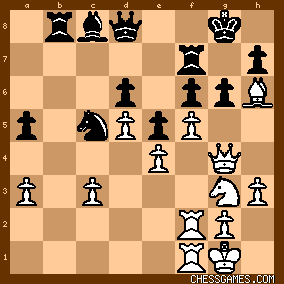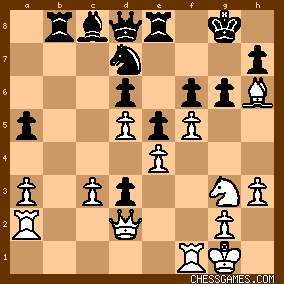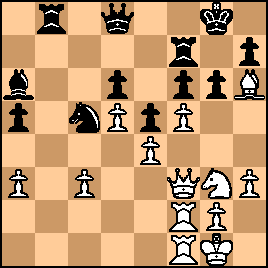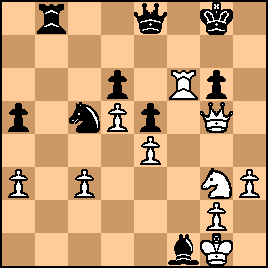|
< Earlier Kibitzing · PAGE 3 OF 3 ·
Later Kibitzing> |
Jun-20-15
 | | Sally Simpson: Not too sure we can blame Carlsen's reluctance to play h6 as a key losing move. (though h6 is probably a theoretical move.) Before I go any further I have to say I do not like this variation. d4 locks it and gives Black the c5 square for a Knight. It's a pro and con situation. Some will like it, some not. I like Black. The game and the Kingside attack.
Perhaps allowing the whole Nh2-g4-h6 manoeuvre was an error. Here:
Instead of 19...Bc8 which is far too late and displays some jittery play from Carlsen, how's about 19...h5. 
click for larger viewThat stops the Ng5 idea and whilst the Knight are getting themselves re-organised step out of the f6 pin and get the Queenside going. And don't balk. h5 holding up a White attack figures in the KID and the Dragon. If you are looking for a smoking gun I'm up for 26...f6 here: 
click for larger viewHe's inviting f5 (which was played the next move). Moving pawns where you are weaker was a known no-no back in the days of Steinitz. He's banked on Anand taking back on d3 here.

click for larger viewwhen after 29.Qxd3 Qb6+ Black is back in it.
When you play moves like f6 you just know there will be a White cute move somewhere and Anand is of the class to find it. White's 29.Qd1! Carlsen missed it but his hackles should have been up and f6 avoided as long as possible.
Generate some counter-play and only play f6 type moves if forced. 26...f6 is not forced. What was it is my Grandad said:
"Stop doing that or you will go blind."
No it was about chess.
"Never have a pop at a move unless you can offer an alternative." Slip in 26...Qb6 or maybe having the highest 4 digit number since Greco was in nappies means one longer needs to stoop to hacking. 
click for larger viewPut some cheapo's on the board, wreck his train of thought, upset him, bluff him, plant a seed of doubt. Fight, trick trap and steal. White will have to deal with it then play Nb3 kick a Queen the to e-file and consider exf4 and Ne5. Anand's good but he has a history and Black needs a blunder to get back into the game. He won't do it playing like one of Capablancca's I'll roll over and you mate me opponents. there's more.... |
|
Jun-20-15
 | | Sally Simpson: More...
Here: I wonder what was going through the players minds. 
click for larger viewCarlsen played 33....g5. First he invites a free f5 and now he could have made Anand's move for him. 34.h4.is so obvious. I was thinking of 33...Bc8

click for larger viewAnd here I'm wondering - Did both players see the Queen Sac starting
with fxg6.
Surely Carlsen must have seen 33...Bc8 as nicking the exchange on f1 is not putting up a fight. The defensive plan with this Bxf1 move was to sac-back the exchange for that h6 Bishop. I cannot decide other than it looks good for White. Not one I'd like to defend against Annand. There again would Anand have sacced his Queen, his position after Bc8 is still good and in this line he does not lose the exchange. Anand has always been a class act, he's played some attacking masterpieces and still has a few good years left, but I bet if he is honest he will say this was a lot easier than he expected. He faced no counter play at all. Carlsen had two threat in the entire game. 31...Nc5 chasing the Queen to very square it wanted to go and 32...Ba6 which was just ignored. As for Carlsen, he's been kidnapped and replaced with a look-a-like till the ransom money has been paid. |
|
| Jun-20-15 | | visayanbraindoctor: <maxi: <visayanbraindoctor> To me, one of the most fascinating aspects of chess is play in even positions. Tactics, strategy and the human element all come together. Even bluffing comes into play.> It seems to me that Carlsen in this game did not play as actively as he usually does, and as <Sally simpson's> analysis shows. (BTW I prefer analyzing and reading such analysis, which explains the reasons for the moves and what might the players been thinking. Lots of analysis in this site seem to be copy-pasted from chess computers without much explanation. IMO this won't help any beginner or 'patzer' improve his chess, but will tend to turn them into computer-obssessed eval watchers.) It's possible that Carlsen's loss on time to Topalov has affected him, made him less decisive. I believe that playing the closed Spanish against the likes of Anand may not be smart under certain circumstances, especially in one where your equanimity may have been shattered in previous games. Playing the closed Spanish against Anand means you must be prepared for an active defense, since playing automatically will get you into a defensive positions with little counter-play, just as in this game. I gave links to the old games of Capablanca, Fischer, and Karpov, just to demonstrate how dangerous White's advantages are in the closed Spanish if met by passive Black play. Playing Black passively in a closed Spanish against these guys was suicide. Anand is not far off from them. Anand can confidently be expected to torture or impale you if you play the closed Spanish against him without the necessary mental attitude. <Sally Simpson> Nice comprehensible analysis. <1d410: <visayanbraindoctor: Very rarely one gets the impression that Carlsen (although erring minimally) gets positionally outplayed. It almost never happens but such games, such as the one Naiditch won against him, are a cause for wonder.> Are you speaking of the game in the chess olympiad?> Yes. |
|
| Jul-31-15 | | Chessman1504: I was a little naive thinking someone of Anand's class could not beat Carlsen in this way. The way he conducted the attack is reminiscent of the Kasparov vs Karpov matches. I'm sure he wanted this kind of position in the first world championship match as opposed to the Berlin endgame and other Berlins played. |
|
Sep-29-15
 | | Phony Benoni: As a True American, I of course read the pun as "Icky Magnus Day." I'll leave the true explication to our Latin scholars. |
|
Sep-29-15
 | | al wazir: What happens after 41...Qa7 ? If 42...Qh6 (threatening 43. Qf6+) or 42. Nxd6, then 42...Nxe4+. |
|
Sep-29-15
 | | al wazir: <Phony Benoni: As a True American, I of course read the pun as "Icky Magnus Day." I'll leave the true explication to our Latin scholars.> It's even more illiterate than usual. Stick with "Icky." |
|
| Sep-29-15 | | mrknightly: "Ecce Magnus Dei" means "Behold the great god." It's a reference to John 19:5 where after scourging Jesus and putting a crown of thorns on him, Pontius Pilate says, Ecce Homo, "Behold the man." Thus, Ecce Magnus Dei I suppose is a play on Ecce Homo meaning that Magnus Carlsen, the king of chess, is condemned by the results of this game, and is presented as defeated and scourged. The scene has been portrayed in many classical works of art. |
|
Sep-29-15
 | | Honza Cervenka: Another explanation of the pun can be a reference to John the Baptist's words on Jesus in John 1:29: "The next day John seeth Jesus coming unto him, and saith, Behold the Lamb of God, which taketh away the sin of the world." Behold the Lamb of God (in Latin: Ecce Agnus Dei) inscription is quite common "attribute" of John the Baptist in Catholic iconography. And Magnus looked a bit like a lamb in this game.... |
|
Sep-29-15
 | | moronovich: <(in Latin: (Ecce Magnus Dei).> I knew he was a chosen one.. |
|
Sep-29-15
 | | al wazir: <Honza Cervenka: Another explanation of the pun...> Oh for [fill in blank]'s sake!
The intended pun was on Magnus, which sounds like "agnus": "Agnus Dei" means "lamb of God" (https://en.wikipedia.org/wiki/Agnus...). But "magnus" too is a latin word, meaning "great." So the words "Ecce Magnus Dei" translate literally as "Behold great of God." The punster thought himself a pandit, i.e., one skilled in Sanskrit, and by implication, other ancient languages as well (https://en.wikipedia.org/wiki/Pandit), but revealed himself to be a *pundit* -- a talking head (https://en.wikipedia.org/wiki/Pundit). |
|
| Sep-29-15 | | talljack: Forgive the ignorant query of a patzer, but why did Magnus give up the rook at move 43? |
|
| Sep-29-15 | | kevin86: The champ goes down to his rival. |
|
| Sep-29-15 | | mrknightly: <Honza Cerenka> Think your suggestion is better then mine, but mine fits, too. |
|
| Sep-29-15 | | benjaminpugh: talljack: No way to save it. The rook is attacked by the knight and only has two moves to safe squares. If Rg7, then Rf8+ and mate to follow (Rg8, Rxg8#). If Rh6, then still Rf8+, Kg7, then Rc8 attacking black's knight and setting up a knight fork on f5 attacking the rook, king, and d pawn protecting the knight. |
|
| Sep-29-15 | | talljack: Thanks Benjaminpugh |
|
| Sep-29-15 | | Jambow: Ok I know very little Latin and my English is only marginally better, but I think the simple idea is observe the Magnificent God of chess fall. No matter great game love the direction it took from the beginning until the end, Anand played worthy of his former status as Cassia's Dei. |
|
| Sep-29-15 | | morfishine: Enough with the nauseating repetitive magnus play on words...JFC |
|
Sep-29-15
 | | perfidious: <visayan....I believe that this was one of Karpov's strategic mistakes in playing against Kasparov. From 1974 to 1984 the chess world was essentially in a Carlsen-like era, with one seemingly immovable champion, who played safe unbeatable openings....> While Karpov was virtually impossible to defeat during that epoch--outside his matches with Korchnoi, one or two losses per year was not at all unusual, therefore two such noughts in October Revolution 60th Anniversary (1977) was extraordinary--his play was not necessarily safety first, a la Petrosian, a point noted by Botvinnik circa 1978. <....Then Kasparov came along and proved that crazy tactical play can occasionally trump the sound and the safe, but only because Karpov decided to play him in his tactical ball park.> It will be noted that Karpov's loss in the decisive game of Karpov - Kasparov World Championship Match (1985) featured Karpov sticking to his tried and true 1.e4, but in subsequent matches, he shifted largely to 1.d4, staying altogether within the realm of semi-closed or close openings. From Karpov vs Kasparov, 1985, there is some enlightening kibitzing by <DrMAL>, a user once familiar hereabouts, though regrettably, no longer. In particular, the discussion of style by Kasparov is of interest: <DrMAL: One other point to bear in mind concerning Kasparov's condemnation of 23.Be3 has to do with style. This is maybe best appreciated by watching his video from beginning to end (perhaps several times) where he so lucidly explains the revolution in chess that he and Tal (and Fischer along with others to lesser extent) brought about. I think his manner of explaining it in terms of 3-D material versus time (tempo) versus quality is best. Karpov was more of a "classical" player valuing material and quality over tempo this style basically defines his legendary great Positional play. Attacking players value tempo more, this basically defines the style. 23.Be3 was a Positional move, it certainly was a good one in terms of quality. However, the timing was such that, 23.f5! was superior. In making his "Karpovian" 23.Be3 as Kasparov dramatically emphasizes in his video, the point is driven home. I don't think Kasparov's objective was to disparage Karpov or even build himself up so much as to simply emphasize the importance of understanding this. I agree with him and, even if he gets dramatic at times (we all have our communication styles), I can very much appreciate his teachings here. His play and his many analyses define the biggest contribution he gave to chess. And that overall, I think, has not been equaled by any other player.> |
|
| Sep-29-15 | | newhampshireboy: Nice game by Vishy. I wish he had played like this during the world championship match! |
|
| Oct-04-15 | | Jambow: Not that I would expect Anand to come out on top vs Carlsen in a long match, but this dynamic active style that defined Vishy before he went into turtle mode, was his best chance as seen here. |
|
| Aug-10-21 | | Gaito: 
click for larger viewBLACK TO MOVE
26...f6?!
Magnus Carlsen is the best player on the planet and of course he always knows what he is doing, but it seems that the engine (SF14) does not quite like this move. Stockfish 14 suggests that Black play instead 26...Nb3 27.Qf2 Qb6 with a very tiny advantage for White (computer evaluation after 30 seconds: +0.84).
On the other hand, after the moves actually played 26...f6?! 27.f5! the evaluation suddenly jumps to +1.81. |
|
| Aug-10-21 | | Gaito: 
click for larger viewWHITE TO MOVE
Anand used two tempi to capture Black's d3-pawn (29.Qd1 and 31.Qxd3). This waste of a valuable tempo was also criticized by the silicon monster (SF14). The engine believes that White should have taken the pawn in one move: 29.Qxd3 Qb6+ 30.Kh2 Ba6 31.c4 and White has a winning advantage according to SF14. (computer evaluation: +5.17) |
|
| Aug-10-21 | | Gaito: 
click for larger viewWHITE TO MOVE
Anand's brilliant exchange sacrifice 33.Qg4! is reminiscent of Tigran Petrosian's typical intuitive exchange sacrifices. Also deserving attention was the alternative 33.fxg6!?, for example: 33...hxg6 34.Qg4 Kh7 35.Bg5! (35.Qh4 is worthy of consideration) Bxf1 36.Qh4+ Kg8 37.Bxf6, and White's attack is overwhelming (computer evaluation: +5.59) (See diagram below):

click for larger viewFurther there might follow 37...Rxf6 38.Rxf6 Qe8 39.Qg5 and Black is busted (see diagram below):

click for larger view |
|
| Aug-10-21 | | Gaito: From the last hypothetical variation (see previous diagram), should Black play 39...Kh7 (what else?) the following position would have been reached:

click for larger viewThen White could finish off the attack with 40.Nf5!
The engine assures that there is forced mate in 19 moves. (We have to believe what the engine says. It never lies) |
|
 |
 |
|
< Earlier Kibitzing · PAGE 3 OF 3 ·
Later Kibitzing> |





































